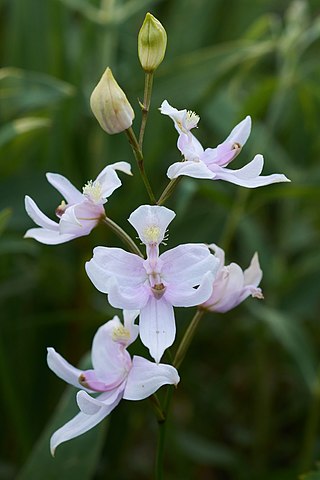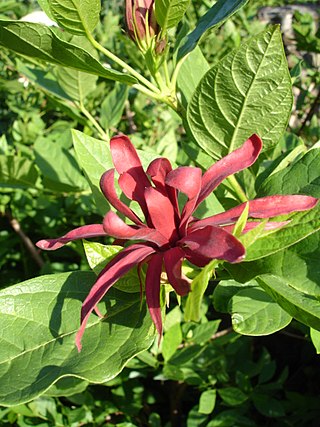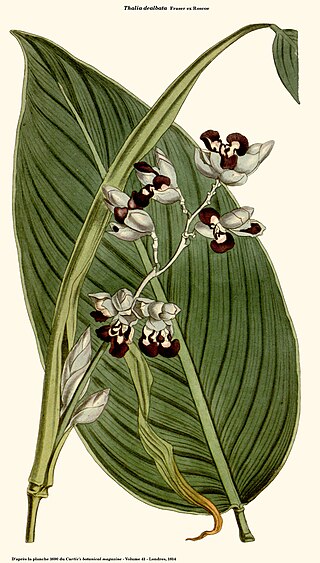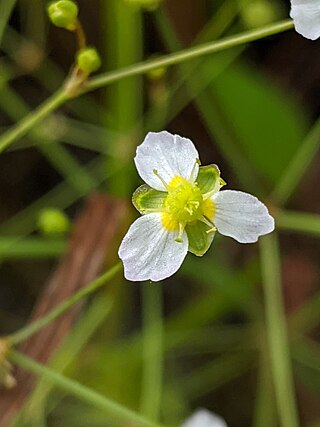
Calopogon oklahomensis, commonly known as the Oklahoma grass pink or prairie grass pink, is a terrestrial species of orchid native to the United States. It is restricted to the states of Alabama, Arkansas, Georgia, Illinois, Indiana, Iowa, Kansas, Louisiana, Minnesota, Mississippi, Missouri, Oklahoma, South Carolina, Tennessee, Texas, and Wisconsin. It is extirpated throughout most of its range. Calopogon oklahomensis is a perennial herb with flowers that are white, pink or purple, with a labellum with an apical region of yellow hairs. Flowers bloom March to July. Its habitats include coastal prairies, savannas, edges of bogs, and oak woodlands. It was described by Douglas H. Goldman in 1995.

Gaillardia pulchella is a North American species of short-lived perennial or annual flowering plants in the sunflower family.

Calycanthus, called sweetshrub, is a genus of flowering plants in the family Calycanthaceae. The genus includes two to four species depending on taxonomic interpretation; three are accepted by most 21st century sources.

Lilium philadelphicum, also known as the wood lily, flame lily, Philadelphia lily, prairie lily, or western red lily, is a perennial species of lily native to North America.

Eurybia macrophylla, commonly known as the bigleaf aster, large-leaved aster, largeleaf aster or bigleaf wood aster, is an herbaceous perennial in the family Asteraceae that was formerly treated in the genus Aster. It is native to eastern North America, with a range extending from eastern and central Canada through the northeastern deciduous and mixed forests of New England and the Great Lakes region and south along the Appalachians as far as the northeastern corner of Georgia, and west as far as Minnesota, Missouri and Arkansas. The flowers appear in the late summer to early fall and show ray florets that are usually either a deep lavender or violet, but sometimes white, and disc florets that are cream-coloured or light yellow, becoming purple as they mature. It is one of the parent species of the hybrid Eurybia × herveyi.

Oxalis violacea, the violet wood-sorrel, is a perennial plant and herb in the family Oxalidaceae. It is native to the eastern and central United States.

Liatris spicata, the dense blazing star, prairie feather, gayfeather or button snakewort, is a herbaceous perennial flowering plant in the family Asteraceae. It is native to eastern North America where it grows in moist prairies and sedge meadows.

Phlox paniculata is a species of flowering plant in the phlox family (Polemoniaceae). It is native to parts of the eastern and central United States. It is extensively cultivated in temperate regions as an ornamental plant and has become established in the wild in scattered locales in other regions. Common names include fall phlox, garden phlox, perennial phlox, summer phlox, and panicled phlox.

Ribes aureum, known by the common names golden currant, clove currant, pruterberry and buffalo currant, is a species of flowering plant in the genus Ribes native to North America.

Thalia is a genus of flowering plants in the Marantaceae family found mainly in aquatic, marshy and riparian zones in Eastern, Central and Western Africa—as far south as Zimbabwe—and the Americas, from Illinois in the north, through northern Argentina in the southern part of its range. These plants can grow with their roots and rhizomes fully submerged and their foliage growing emersed from the water's surface. They thrive in floodplains, vernal pools and other seasonally-inundated areas, as well. Alligator-flag is a common name for plants in this genus. The generic name is in honor of Johannes Thal (1542–1583), a German doctor who wrote A Flora of the Harz Mountains.

Alisma triviale, the northern water plantain, is a perennial semi-aquatic or aquatic plant in the water-plantain family (Alismataceae).

Ceanothus americanus is a species of Ceanothus shrub native to North America. Common names include New Jersey tea, Jersey tea ceanothus, variations of red root, mountain sweet, and wild snowball. New Jersey tea was a name coined during the American Revolution, because its leaves were used as a substitute for imported tea.

Chelone obliqua, the red turtlehead, rose turtlehead or pink turtlehead, is a perennial flowering plant belonging to the family Plantaginaceae. This uncommon wildflower is endemic to the United States, where it is found in the Midwestern and southeastern states.

Hymenocallis occidentalis is a plant species native to the southern United States. It is known along the Gulf Coast from South Carolina to Texas, and in the Mississippi Valley as far north as southern Illinois and Indiana. It is also cultivated as an ornamental elsewhere because of its showy, sweet-smelling flowers. Common names include woodland spider-lily, hammock spider-lily or northern spider-lily.

Styrax americanus, the American snowbell or mock-orange, is a plant species native to the southeastern United States and the Ohio Valley. It has been reported from Texas and Florida to Virginia and Missouri. It generally grows in swamps and on floodplains and in other wet locations.

Orbexilum pedunculatum, commonly known as Sampson's snakeroot, is a species of flowering plant in the legume family. It is native primarily to the Southeastern United States where it is found in prairies and savannas, often in acidic soil. It is a perennial that produces racemes of flowers in early summer.

Iris prismatica, the slender blue flag or cubeseed iris, is a plant species native to parts of the southern and eastern United States from Maine south to Alabama, as well as to the Canadian provinces of Ontario and Nova Scotia.

Liparis liliifolia, known as the brown widelip orchid, lily-leaved twayblade, large twayblade, and mauve sleekwort, is a species of orchid native to eastern Canada and the eastern United States. It can be found in a variety of habitats, such as forests, shrublands, thickets, woodlands, and mountains. The orchid is considered globally secure, but it is considered rare or endangered in many northeastern states.

Solidago radula, the western rough goldenrod, is a North American plant species in the family Asteraceae. It is found primarily in the southern Great Plains and the Mississippi Valley of the United States, with isolated populations farther east in Kentucky, Georgia, and the Carolinas.

Hymenopappus scabiosaeus, the Carolina woollywhite, is a North American species of flowering plant in the daisy family. It grows in the central and southeastern United States, primarily on the Great Plains an on the Coastal Plain of the Southeast. There are also isolated populations in Illinois and Indiana as well as in the state of Coahuila in northern Mexico.






















